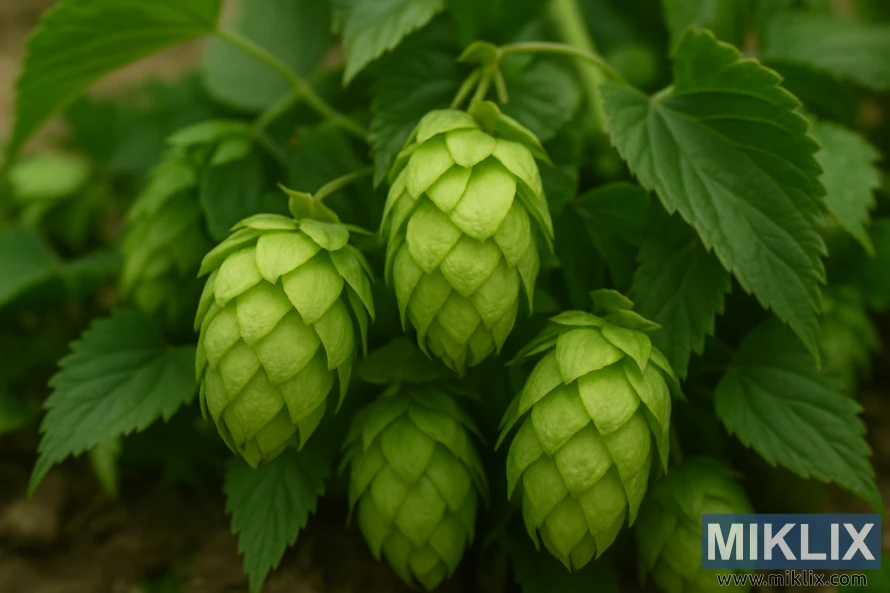Image: Fresh East Kent Golding Hops
Published: July 24, 2025 at 6:12:33 PM UTC
Last updated: September 27, 2025 at 12:19:07 PM UTC
Detailed close-up of East Kent Golding hops showing vibrant green cones and papery texture, highlighting their complex aroma and artisanal quality.
This evocative close-up photograph captures a living portrait of East Kent Golding hops, one of the most cherished hop varieties in traditional British brewing. The foreground is dominated by a cluster of cones, their overlapping bracts forming perfect, teardrop-shaped structures that seem almost hand-crafted by nature itself. Each scale glistens faintly in the soft natural light, its delicate papery texture highlighted with precision, revealing a spectrum of green shades from pale lime at the tips to deeper, richer tones at the base. The cones appear both fragile and resilient, their compact forms housing the golden lupulin that is the lifeblood of their aromatic contribution to beer. The lighting is diffuse and gentle, casting no harsh shadows, instead wrapping the hops in an even illumination that emphasizes their vibrant freshness.
Surrounding the cones, the broad, serrated leaves of the hop bine spread outward, their deep, verdant green forming a lush backdrop that amplifies the brightness of the cones themselves. Veins within the leaves catch the light subtly, giving them a three-dimensional quality and suggesting the steady flow of nutrients that nourish the plant from the fertile Kentish soil below. The image invites the viewer to imagine the gentle rustle of the leaves in a summer breeze, and the faint resinous aroma released when a cone is lightly squeezed—a complex scent of earth, honeyed sweetness, and soft citrus mingling together.
In its composition, the photograph situates the hops not as isolated specimens, but as living components of a thriving ecosystem. The cones hang gracefully from supple stems, suggesting readiness for harvest, yet also reflecting the cycle of growth, cultivation, and renewal that has defined hop farming for centuries in the Kent countryside. This grounding in nature connects directly to the artisanal heritage of brewing. The East Kent Golding variety, first cultivated in the 18th century, remains a cornerstone of English brewing tradition, prized for its balance of subtle bitterness and refined aromatic qualities. Its contributions to classic styles—bitters, pale ales, porters, and traditional English IPAs—are legendary, imparting a restrained yet distinctive character that is earthy, floral, slightly spicy, and delicately sweet.
The mood of the image is one of reverence and craftsmanship. It does not present the hops in isolation from their origins but instead situates them within their natural context, surrounded by the very leaves that nourished them and the soil implied just beyond the frame. The cones symbolize not just raw ingredients, but a legacy of brewing knowledge passed down through generations. Their very presence evokes the careful labor of farmers tending their bines through the seasons, the anticipation of harvest, and the artistry of brewers who transform these green cones into liquid expressions of culture and history.
At its heart, the photograph reminds the viewer that great beer is rooted in the land. Every pint brewed with East Kent Goldings carries within it the story of these cones: their growth under gentle English skies, their harvest at peak maturity, and their infusion into recipes that honor centuries of tradition. The careful focus on the cones, balanced by the soft blur of surrounding leaves, creates a sense of intimacy with the plant itself, encouraging the viewer to pause and appreciate not just the science, but the artistry inherent in brewing.
The image is related to: Hops in Beer Brewing: East Kent Golding

